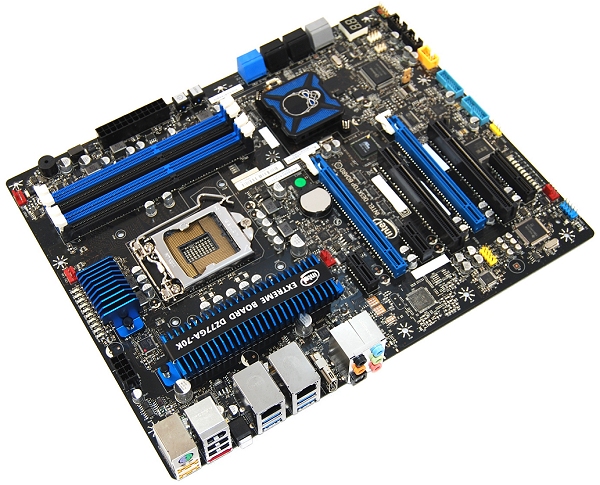Continuing its tick-tock release cycle, Intel plans to unveil a new CPU microarchitecture at the end of April. Codenamed Ivy Bridge (tick), the update will bring a 22nm die shrink of current 32nm Sandy Bridge technology (tock), bringing greater efficiency and allowing Intel to cram more into the same size die.
Intel is often criticized for introducing too many new chipsets and sockets, but this isn't usually the case with "ticks" as the microarchitecture is largely the same as the preceding "tock." Such is the case with Ivy Bridge, which uses the same LGA1155 socket introduced in early last year alongside Sandy Bridge.
Folks who already own Cougar Point (6-series chipset) motherboards will be able to upgrade to Ivy Bridge without purchasing a completely new platform. Besides the fact that manufacturers will have to supply a BIOS update to add Ivy Bridge support on 6-series motherboards, compatibility is guaranteed.

Although backwards compatibility with 6-series motherboards will be available, Intel couldn't resist the opportunity to accompany its latest architecture with a fresh round of chipsets. Codenamed "Panther Point," the new 7-series chipsets include half a dozen parts, with the Z77 being Intel's new flagship.
We expect many performance fiends to question whether upgrading to a 7-series board is worthwhile, and we wouldn't be surprised if some budget builders are interested in discounted secondhand 6-series boards. We'll offer an overview on Panther Point offers so you can make an informed shopping decision.
Today's chipsets are merely responsible for I/O and have little bearing on performance. In fact, they're not even really a "chipset" anymore as there isn't a set of chips. Years ago, it was common for chipsets to have a northbridge and southbridge. The former was the direct line of communication between the CPU, GPU and memory, while the latter handled everything else from expansion slots to storage.
However, as features such as the memory controller were moved from the northbridge to the CPU itself, the chip played less of a role. Eventually, Intel took what was left of the northbridge and added it to the southbridge in what the company calls a PCH or Platform Controller Hub. The 6-series' flagship PCH (the Z68, introduced last May) only has relatively subtle differences to the 7-series flagship (the Z77).
| 6 Series | 7 Series | |
|---|---|---|
| CPU Support | Sandy Bridge / Ivy Bridge | Sandy Bridge / Ivy Bridge |
| CPU I/F | DMI 2.0 | DMI 2.0 |
| Package | MB: 25 x 25 mm, DT: 27 x 27 mm | MB: 25 x 25 mm, DT: 27 x 27 mm |
| USB | 14 USB 2.0 | 14 USB Ports (Up to 4 USB 3.0) |
| PCIe | 8 PCIe 2.0 | 8 PCIe 2.0 |
| Storage | 2 SATA Gen 3, RAID, 4 SATA Gen 2 | 2 SATA Gen 3, RAID, 4 SATA Gen 2 |
| PCI | DT: 4 slots | DT: PCI on B/Q SKUs only |
| Display I/Fs | VGA, LVDS, DP, HDMI (w/ cost reduced LS), Wireless Display | VGA, LVDS, DP, HDMI (w/ cost reduced .LS), Wireless Display |
| Display Pipes | Dual Independent. Display Digital I/Fs | Three Independent. DisplayDigital I/Fs |
| Security | PAVP | PAVP |
| Manageability & FW | ME 7.0 | ME 8.0 |
| iRST | 10.0 and 10.5 (Intelligent caching and Optical Read Ahead) | 11.0 w/Intelligent caching |
| LAN | GbE MAC | GbE MAC |
| Integ. Clock | Yes | Yes |
Both chipset generations support all Sandy Bridge and Ivy Bridge processors, they use the same DMI 2.0 (Direct Media Interface) to connect the PCH and CPU with 20 Gbit/s of bandwidth using a x4 link. They are also the same size at 27 x 27mm and they support eight PCIe 2.0 lanes as well as single Gigabit MAC.
Folks hoping for better storage capabilities will be disappointed as the 7-series brings the same six SATA ports (two 6Gb/s). Intel has remained cautious about upgrading its 6Gb/s support after the reliability problems with initial 6-series boards. We were hoping to see wider SATA 6Gb/s support this time.
However, Panther Point isn't entirely stagnant as Intel has finally implemented native USB 3.0 support – albeit not full USB 3.0 support as just four of the fourteen ports offer SuperSpeed bandwidth. Nonetheless, this does mean that all 7-series motherboards will feature at least four USB 3.0 ports.
Interestingly, one of the most significant changes to the 7-series is the removal of a feature. Whereas 6-series chipsets supported four PCI slots, the 7-series almost completely eliminates native PCI support. We say "almost" because the business and corporate Q75, Q77 and B75 chipsets still support PCI.
It is also worth noting that all 7-series chipsets can use the GPU inside Intel's processors, so you'll be able to use the video outputs on H77, Z75 and Z77 motherboards. Before the Z68, things were a bit confusing as the P67 was the only chipset for overclockers, but it couldn't tap Intel's integrated graphics.
